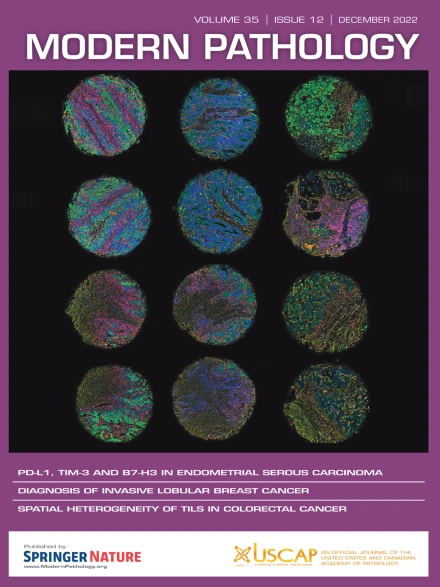Comprehensive Molecular, Pathological, and Clinical Characterization of Clear Cell Adenocarcinoma of the Urinary Tract
IF 7.1
1区 医学
Q1 PATHOLOGY
引用次数: 0
Abstract
Clear cell adenocarcinoma of the urinary tract (utCCA) is a rare, Müllerian-type tumor typically arising in the urethra of female patients with poorly understood pathogenesis. Here, we report the clinical, pathologic, and molecular characterization of a cohort of utCCA treated at a tertiary referral center. Cases were centrally reviewed, and immunohistochemistry and whole exome and targeted sequencing were performed. The landscape of somatic alterations was compared with ovarian and uterine clear cell carcinoma, and urothelial carcinoma. Among 35 utCCA, most patients were female (86%), and the most common primary tumor site was the urethra (83%) in association with urethral diverticula (51%). Median disease-free and overall survival rates were 42 and 65 months, respectively. The most common mutations were in ARID1A and TP53. Mutations in TERT promoter and other chromatin-modifying genes were rare. Phylogenic analysis suggested that utCCA arises from a dysplastic clear cell precursor developing within the diverticular lining. Although this is the largest study of utCCA to date, the study is limited by its small sample size, retrospective design, and clinical heterogeneity of the cohort. Molecular analysis of utCCA, including multiregion sequencing of tumor and adjacent urethral and diverticular lining, supports a potential mechanism of disease pathogenesis in which most utCCA arise from regions of clear cell dysplasia, possibly resulting from chronic inflammation in the setting of urinary stasis, and not through a progression from intestinal metaplasia or divergent differentiation of a precursor urothelial carcinoma.
泌尿道透明细胞腺癌的综合分子、病理和临床特征。
尿路透明细胞腺癌(utCCA)是一种罕见的勒氏型肿瘤,通常发生在女性患者的尿道中,其发病机制尚不清楚。在这里,我们报告了在三级转诊中心治疗的utCCA队列的临床、病理和分子特征。病例集中回顾,并根据需要进行免疫组织化学。进行全外显子组和靶向测序。体细胞改变的景观比较卵巢CCA,子宫CCA和尿路上皮癌(UC)。35例utCCA中,女性居多(86%),最常见的原发肿瘤部位为尿道(83%),伴尿道憩室(51%)。中位无病生存期和总生存期分别为42个月和65个月。最常见的突变是ARID1A和TP53。TERT启动子和其他染色质修饰基因的突变罕见。系统发育分析表明,utCCA起源于憩室内膜内发育不良的透明细胞前体。虽然是迄今为止最大的utCCA研究,但该研究受到样本量小、回顾性设计和队列临床异质性的限制。utCCA的分子分析,包括肿瘤和邻近尿道和憩室内膜的多区域测序,支持了一种潜在的疾病发病机制,其中大多数utCCA产生于透明细胞发育不良区域,可能是由尿瘀的慢性炎症引起的,而不是通过肠道化生或前体UC的分化进展。
本文章由计算机程序翻译,如有差异,请以英文原文为准。
求助全文
约1分钟内获得全文
求助全文
来源期刊

Modern Pathology
医学-病理学
CiteScore
14.30
自引率
2.70%
发文量
174
审稿时长
18 days
期刊介绍:
Modern Pathology, an international journal under the ownership of The United States & Canadian Academy of Pathology (USCAP), serves as an authoritative platform for publishing top-tier clinical and translational research studies in pathology.
Original manuscripts are the primary focus of Modern Pathology, complemented by impactful editorials, reviews, and practice guidelines covering all facets of precision diagnostics in human pathology. The journal's scope includes advancements in molecular diagnostics and genomic classifications of diseases, breakthroughs in immune-oncology, computational science, applied bioinformatics, and digital pathology.
 求助内容:
求助内容: 应助结果提醒方式:
应助结果提醒方式:


